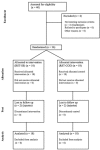Short-Term Repeated-Sprint Training (Straight Sprint Vs. Changes of Direction) in Soccer Players
- PMID: 31915488
- PMCID: PMC6942460
- DOI: 10.2478/hukin-2019-0040
Short-Term Repeated-Sprint Training (Straight Sprint Vs. Changes of Direction) in Soccer Players
Abstract
Repeated-sprint training (RST) is considered a critical training method in team sports. It is well known that RST effects may depend on several variables such as the duration of the protocol and repeated-sprint methodology. Few studies have evaluated very short-term protocols and compared different RST modalities. The aim of this study was to compare the effectiveness of 2 week RST including straight sprints or changes of direction (CODs) on physical performance in a sample of soccer players. This study used a randomised pre-post parallel group trial design. The participants were assigned to either an RST group using straight sprints (RST-SS = 18 players) or an RST group using CODs (RST-COD = 18 players). The protocols were: 3 sets of 7 x 30 m sprints for the RST-SS and 7 x 20 + 20 m (one COD of 180°) for the RST-COD, with 20 s and 4 min recovery between sprints and sets, respectively. The following evaluations were performed: 10 and 20 m sprint, agility test, repeated sprint test (RSTbest and RSTmean), and Yo-Yo Recovery Level 1. After the training period, the RST-SS did not report any performance variation, while the RST-COD showed improvements in the 10 m sprint and RSTbest (effect size = 0.70 and 0.65, respectively). The between-group analysis did not report any statistical difference between the RST-SS and the RST-COD. In conclusion, this study did not support the utilisation of a very short-term RST protocol with soccer players, however, the RST-COD presented some additional benefits in sprint performance compared to the RST-SS.
Keywords: changes of direction; performance; soccer; team sports; training.
© 2019 Marco Beato, Giuseppe Coratella, Mattia Bianchi, Emanuele Costa, Michele Merlini, published by Sciendo.
Figures
References
-
- Beato M, Coratella G, Schena F, Impellizzeri FM. Effects of recreational football performed once a week (1 h per 12 weeks) on cardiovascular risk factors in middle-aged sedentary men. Sci Med Footb. 2017;1:171–177. doi: 10.1080/24733938.2017.1325966. - DOI

